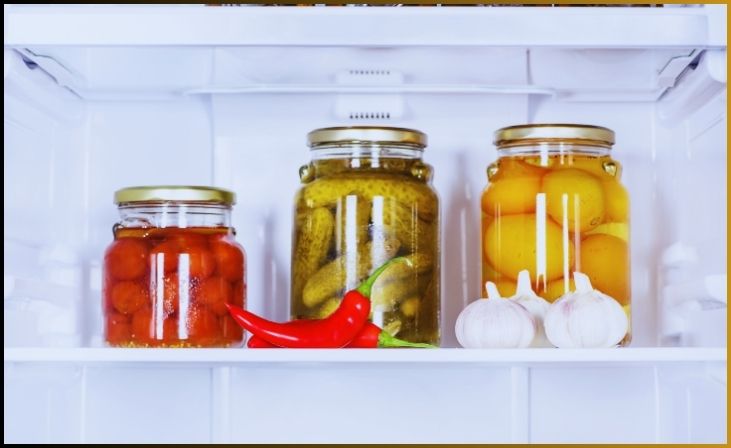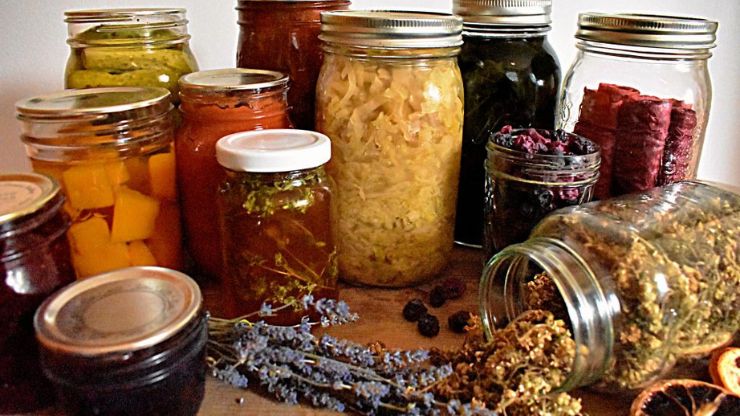In today’s age of technology and convenience, preserving food without the need for freezing or canning may sound like a lost art, but it’s a valuable skill that has been passed down through generations. Whether you’re looking to reduce your reliance on electricity or simply wish to explore alternative methods of food preservation, this guide will take you on a journey through traditional techniques that have stood the test of time. From pickling and fermenting to drying and root cellaring, there are numerous ways to ensure your food stays fresh and delicious without the modern trappings of refrigeration or canning. Join us as we uncover the secrets of preserving food the old-fashioned way.
Easy Methods for Preserving Food
If you’ve ever found yourself with a surplus of homegrown fruits and vegetables, this guide offers five straightforward methods to ensure none of your produce goes to waste. Instead of feeling overwhelmed by the abundance of zucchinis, green beans, peas, tomatoes, or apples, you can take advantage of these easy preservation techniques to savor your harvest months later.
- Dehydration: Removing moisture from your fruits and veggies is an excellent way to extend their shelf life. Dehydrated produce is not only space-efficient but also perfect for snacking or use in various recipes.
- Freezing: Freezing is a simple and effective way to preserve the freshness of your harvest. Whether it’s blanched vegetables or frozen berries, your freezer can be a valuable ally in food preservation.
- Winemaking: Turn excess fruit into flavorful wines. It’s a creative way to enjoy your harvest and make delicious beverages for special occasions.
- Fermentation: Unlock the world of fermentation to preserve your produce. From sauerkraut to pickles, fermentation not only extends the life of your vegetables but also provides you with gut-friendly, probiotic-rich foods.
- More Methods: Check out the accompanying video for an introduction to these methods, and discover additional ways to preserve your bounty at the end of this article.
So, if you’re faced with an abundance of garden-fresh goods, fear not. These simple, safe, and training-free preservation methods will ensure your harvest is enjoyed for months to come without the need for pressure canning.
Quick Link: Sourdough Belgian Waffles
Maintaining Food Supply Through Preserving

Throughout history, people have developed ingenious methods to preserve food without relying on canning or refrigeration. This necessity-driven ingenuity allowed them to ensure a year-round food supply, adapting to the resources and available crops of their regions. Different cultures and eras each had their favored preservation techniques and storage solutions, shaped by environmental conditions, accessible food sources, and available storage options.
For instance, in areas where pottery and basket-weaving were prevalent, grains and seeds were often dried and safely stored for both cooking and beer production. In contrast, some cultures, particularly in northern regions with limited agriculture and pottery, relied on protein sources like fish, seals, caribou, deer, and whales. They employed methods such as air drying, pickling, smoking, or fermentation to extend the edibility and nutritional value of these protein sources for months or even years. Remarkably, some of these preserved foods were stored in the ground without conventional containers, showcasing the power of necessity as the mother of invention.
Today, in your kitchen, you have a wide range of preservation options and modern techniques at your disposal. To create an effective preservation strategy, consider your family’s food and beverage preferences. Focus on preserving the kinds of food you regularly consume to avoid making excess quantities of items like thirty jars of green tomato relish when you only go through six jars in a year.
Preserving Food Without Using a Canner
In our journey through food preservation, we’ll delve into five primary techniques: drying (dehydrating), fermenting, pickling, making jams and jelly, freezing, and even venturing into winemaking and natural state (dry storage). Additionally, we’ll touch on more advanced preservation methods towards the end, although these might be better suited for different types of food beyond fresh produce.
It’s important to note that you can employ multiple preservation methods for a single type of fruit or vegetable. For example, onions can be preserved in their natural state, dried, utilized in pickles or ferments, and even frozen, among other possibilities. Experimenting with various preservation styles for each crop can add a delightful variety to your meals, ensuring that every dish remains interesting and flavorful.
Using a freezer to Preserve food

Freezing stands out as one of the most straightforward techniques for preserving food, ensuring its deliciousness for extended periods. This method serves as an excellent long-term storage solution, suitable for a wide range of food items, including various fruits and vegetables. My freezer is currently brimming with an assortment of goodies, from broad beans and snap peas to basil cubes and a bounty of berries!
While some foods can be effortlessly stored in the freezer without any prior preparation, certain vegetables benefit from blanching or steaming before freezing. My preferred approach for preserving fresh produce involves initially placing it on a tray lined with baking paper. Once the items are frozen, they can be conveniently transferred to freezer bags. This process prevents food from sticking together in a solid block and mitigates the risk of freezer burn, ensuring that your frozen produce remains in pristine condition.
Preserving food by fermenting vegetables
Fermented foods are an absolute delight, not only for their enticing taste but also for their remarkable impact on your digestive well-being. These culinary treasures, rich in natural probiotics, play a pivotal role in replenishing the beneficial bacteria in your gut.
Don't just scroll, subscribe!
BuzzTrail's unique web-stories are the cure for boredom you've been waiting for.
The world of fermented foods is diverse, offering a wide array of options that you can either craft at home or find in stores. From dairy-based classics like yogurt to grain-based wonders and even the effervescent world of kombucha brewed from sugary tea, there’s something to suit every palate. But it doesn’t stop there—vegetables and fruits can also undergo the transformative process of fermentation. Once they attain the perfect flavor profile to tickle your taste buds, you can store them in the fridge for up to six months.
Within the realm of fermented foods, you’ll encounter beloved classics like kimchi and sauerkraut, which have been gracing tables for years. Over the past twelve months, I’ve ventured further into the world of fermented vegetables, experimenting with radishes, turnips, cucumbers, wild garlic, and more. While there are countless recipes and informative books available, the beauty of fermentation lies in its versatility. Virtually any fruit or vegetable can be fermented, resulting in a tangy, slightly salty, and indescribably delectable flavor. These fermented wonders elevate salads, cheese boards, Asian-inspired dishes, and various meaty delights.
What’s truly remarkable about fermentation is its safety and simplicity. The fundamental steps involve preparing the produce—sometimes finely slicing it and at other times leaving it whole. Then, the vegetables are submerged in a sea salt brine, typically around 2% salt concentration, and left to ferment for a duration ranging from one to six weeks. This process is not only straightforward but also incredibly secure, ensuring that you can savor the fruits of your labor with confidence.
Also Read: How to Make Sourdough Starter
Dehydrating Fruit and Vegetables
Dehydration, often regarded as one of the oldest methods of food preservation, involves the complete removal of moisture from edibles. This ancient technique serves as a formidable barrier against the growth of microorganisms and food spoilage. The beauty of dehydrated food lies not only in its extended shelf life but also in the convenience it offers for culinary applications. Dried comestibles can remain in pristine condition for years, making them an invaluable addition to your pantry.
Among the easiest candidates for dehydration are culinary herbs, ideal for enhancing both your cooking and tea-drinking experiences. In a separate piece, I delve into various methods for drying herbs, like the aromatic mint. But the world of dehydration extends beyond herbs, encompassing a spectrum of possibilities. You can opt to dry fruits and vegetables, either as crisp, individual pieces, such as apple chips, or as pureed creations transformed into sumptuous fruit leather.
The fundamental concept behind food dehydration is the extraction of moisture through the use of specialized appliances or the benevolence of warm, arid weather. Once the desiccation process is complete, the dehydrated fare is carefully stored in airtight containers, ranging from classic mason jars and ziplock bags to vacuum-sealed pouches.
Preserving Tips: Fresh Is Always the Best
Before we delve into the five food preservation methods, it’s crucial to emphasize the importance of choosing top-quality herbs, fruits, and vegetables for the best results. When preserving, opt for produce that’s at its peak. Look for items without soft spots, blemishes, or signs of spoilage, such as holes from carrot root flies on your carrots. If you notice some nibbled leaves due to slugs but they are still perky, they are suitable for preservation. However, avoid wilted, bolting, or yellowing leaves, as preserving them won’t enhance their flavor or nutritional value.
In summary, fresh produce is your best bet. The sooner you can preserve it, the more nutrients you’ll retain. For the healthiest and most flavorful preserved food, harvest your crops and aim to preserve them within a day. Prolonging this timeframe may result in softening, flavor changes, or a decrease in nutritional value.
There are exceptions to this guideline. Some fruits, like medlars and persimmons, require bletting before they become palatable. If you’re making jams and jellies, using slightly overripe fruit and berries is acceptable, though using fresh ingredients whenever possible is ideal. I recall my first job as a twelve-year-old strawberry picker, where even the ripest yet least visually appealing berries were picked and sent to a jam-making factory.
If you find produce that’s beyond salvaging, consider composting. While it may not be the perfect solution, it allows you to recycle nutrients into compost, which will nurture the next generation of food plants. There are various composting methods, including bokashi, worm bins, hot composting, and the simplest way to compost.
Bottom Line
In a world dominated by fast-paced living and high-tech solutions, the art of preserving food without freezing or canning is a testament to our ingenuity and adaptability. By rediscovering these time-honored methods, we not only connect with our culinary heritage but also gain a sense of self-sufficiency and resilience. From pickled vegetables to air-dried fruits, these techniques offer a glimpse into the past while providing sustainable solutions for the future. So, whether you’re an enthusiast, a homesteader, or simply curious about the ways our ancestors preserved their harvests, explore these methods and savor the fruits of your labor as you embark on your own food preservation journey.
FAQs
What are the advantages of food preservation without freezing or canning?
What are the advantages of food preservation without freezing or canning?
Preserving food through alternative methods often retains more of the food’s natural flavor and nutritional value. It’s also a practical solution in areas with unreliable electricity or for those seeking a more self-sufficient lifestyle.
What foods can be preserved without freezing or canning?
What foods can be preserved without freezing or canning?
Various foods can be preserved using methods like pickling, fermenting, drying, and root cellaring. This includes fruits, vegetables, herbs, and even some meats.
Are these methods safe for food preservation?
Are these methods safe for food preservation?
When done correctly, these traditional methods are safe and effective for food preservation. Proper sanitation and following established guidelines are essential for success.
How can I get started with food preservation without freezing or canning?
How can I get started with food preservation without freezing or canning?
Begin by researching the specific preservation methods you’re interested in and gathering the necessary equipment and ingredients. Many resources and guides are available to help you get started on your food preservation journey.

